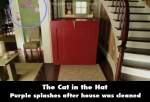
Continuity mistake: At the end of the movie when the Cat finished cleaning up the mess and was packing Thing 1 and Thing 2, everything looks immaculate except in one scene, in the corner of the living room, there are still purple splashes.
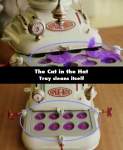
Continuity mistake: When Cat fills up the cupcake tray it is very messy with cupcake batter all over the tray but when he closes the tray it is clean and perfect with the batter in each cupcake holder perfectly.
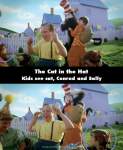
Revealing mistake: In the end of the piñata scene, two of the children look up at the cat. No one else was supposed to see him. (00:47:10)
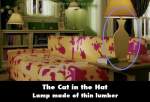
Other mistake: When the things clean Mom's dress, the purple goo goes directly onto the couch on the right side of the room. After Conrad asks about the couch, and the camera pans over to the now filthy couch, look at the end table and lamp. They were in the direct line of fire, but didn't get touched. Also, look closely at the lamp. It appears to be a piece of thin lumber cut into a lamp shape.
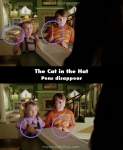
Continuity mistake: In the scene where Conrad and Sally are signing the contract, they have the pens in their hands, but when Cat says, "Give me five!" the pens have disappeared.
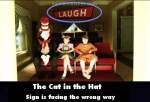
Factual error: In the scene where the kids are viewing the cupcake baking, there is a sign in the corner reading "laugh". The sign is facing towards the chef, when it should be facing the crowd. (00:31:40)
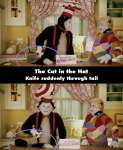
Continuity mistake: In the scene where the cat cuts off his tail, when he first hits it with the knife it bounces off but in the next shot it went through.
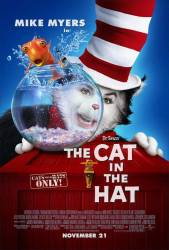





Chosen answer: Theodor Seuss Geisel, or Dr. Suess as we know him, published most of his books between the late 1930's and the late 1980's. "The Cat in the Hat" was first published in 1957. Dr. Seuss' works generally tell the stories of fantastical characters in imaginary places, meant to be timeless. Illustrations and animated adaptations show buildings and objects with unusual proportions, odd shapes and bizarre functions. The live action film of "The Cat in the Hat, " however, is rooted to reality by its decidedly human child protagonists in an ordinary house in an ordinary neighborhood. The production design, costume design and set decoration of the 2003 film seem also to have the goal of achieving a certain timelessness. No date reference is given. However, there a decidedly stylized quality of 1950's-1960's suburban architecture and design, complete with its generic forms, chimneys, picket fences, and colors such as yellows and avocado greens, reflecting the common decor of the time. Similar to the 1971 TV short, which seems to provide a reference point for the design aesthetic of the film, nothing appears exceedingly futuristic nor rooted in period styles like victorian or colonial. I have also posed your question to Rita Ryack, the film's costume designer, whom I found on Facebook. If she sees my questions and decides to respond, I will add her insights to this answer.